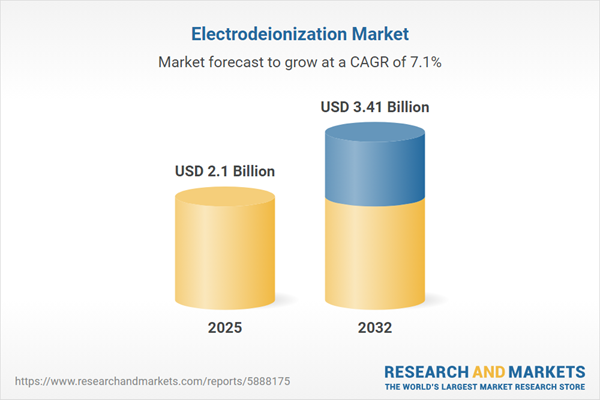Speak directly to the analyst to clarify any post sales queries you may have.
Electrodeionization technology has become a key enabler for organizations seeking effective, compliant, and eco-friendly industrial water treatment. Senior decision-makers benefit from integrating these systems, as they directly address operational imperatives and evolving sustainability expectations.
Market Snapshot: Electrodeionization Market Growth and Performance
The electrodeionization market is experiencing steady growth, reaching USD 1.96 billion in 2024 and projected to expand to USD 2.10 billion in 2025, at a compound annual growth rate (CAGR) of 7.12%. By 2032, the market is forecasted to achieve USD 3.41 billion in value. Critical sectors—including microelectronics, pharmaceuticals, and power generation—are fueling demand, with their focus on high-purity water creating a sustained need for advanced water treatment. As environmental regulations tighten and efficient resource management becomes vital, organizations increasingly turn to electrodeionization solutions to modernize facilities and optimize process reliability.
Scope & Segmentation: Detailed Electrodeionization Market Analysis
- Application Areas: Solutions address microelectronics manufacturing, semiconductor fabrication, pharmaceutical production, various types of power generation plants (thermal, nuclear, renewable), and large-scale industrial or municipal water treatment. These use cases are shaped by unique regulatory, purity, and reliability requirements.
- Module Types: The product range includes plate and frame, spiral wound, and tubular modules. Each type aligns with specific operational and deployment needs, making integration into diverse system layouts straightforward.
- End Users: Chemicals (notably petrochemical and specialty producers), pharmaceutical firms, power generation operations, semiconductor firms, and facilities managing both industrial and municipal wastewater are core industry adopters.
- Configurations: Available in single-stage systems as well as more advanced multi-stage designs, including two-stage, three-stage, and four-stage solutions, to accommodate varying capacity and performance targets.
- Distribution Channels: Products are supplied both directly and through distributor networks, enabling broad market reach and customer-centric service models tailored to local requirements.
- Geographic Coverage: The Americas, Europe, Middle East and Africa, and Asia-Pacific are principal regions. The United States, Canada, China, India, Germany, and Australia are particularly influential, reflecting diverse compliance challenges and growth opportunities.
- Key Companies Tracked: Top industry participants driving innovation and market expansion include Evoqua Water Technologies LLC, Veolia Water Technologies & Solutions, SUEZ Water Technologies & Solutions Inc., The Dow Chemical Company, Danaher Corporation, LANXESS AG, Nitto Denko Corporation, Toray Industries Inc., Aquatech International LLC, and Remondis AG & Co. KG.
Key Takeaways for Senior Decision-Makers
- Electrodeionization systems help organizations advance sustainability policies by minimizing or eliminating chemical usage and supporting low-impact water purification practices.
- Modular formats and flexible system configurations simplify adaptation to existing plant layouts, reducing upgrade complexity and supporting operational efficiency goals.
- Digital monitoring and advanced membrane chemistry enable predictive maintenance, strengthen water quality control, and improve operational transparency.
- Asia-Pacific and Americas regions are prioritizing technology adoption, signaling a strong trend in proactive investment and regulatory alignment.
- Strengthening supplier relationships, especially for critical components and resins, enhances supply chain resilience and future-proofs organizations against evolving compliance needs.
- Adoption of advanced multi-stage and digitally enabled configurations equips industries to address complex production scenarios and maximize system uptime and output quality.
Tariff Impact: Navigating United States Policy Adjustments
Recent United States tariff adjustments have impacted the sourcing of key electrodeionization system components, such as ion exchange resins and specialty polymers. In many sectors, manufacturers respond by focusing on local procurement, forging long-term supplier agreements, and maintaining inventory buffers. These measures are especially important for high-sensitivity domains including semiconductors and pharmaceuticals, where water quality is critical. For industries less affected by water purity issues, a broader approach may be taken. The overall effect is an increased focus on supply chain collaboration and innovation in risk management and component sourcing.
Methodology & Data Sources
This report is based on direct interviews with system integrators, end-users, and technology suppliers in conjunction with academic research, regulatory materials, and financial disclosures. All data and insights have undergone expert validation for accuracy and decision-making relevance.
Why This Report Matters
- Enables executive teams to target the most promising segments by linking direct market trends to strategic organizational objectives.
- Provides procurement and engineering leaders with actionable insights to optimize supply chain management, form strong partnerships, and address region-specific requirements.
- Supports senior leaders as they plan investments, allocate resources, and navigate the forces shaping water treatment innovation and compliance worldwide.
Conclusion
Electrodeionization continues to elevate operational capabilities for organizations, supported by ongoing technical progress and deepening supplier partnerships. Senior leaders can leverage this knowledge for informed decision-making and strategic advancement in water treatment.
Additional Product Information:
- Purchase of this report includes 1 year online access with quarterly updates.
- This report can be updated on request. Please contact our Customer Experience team using the Ask a Question widget on our website.
Table of Contents
3. Executive Summary
4. Market Overview
7. Cumulative Impact of Artificial Intelligence 2025
List of Figures
Samples

LOADING...
Companies Mentioned
The key companies profiled in this Electrodeionization market report include:- Evoqua Water Technologies LLC
- Veolia Water Technologies & Solutions
- SUEZ Water Technologies & Solutions Inc.
- The Dow Chemical Company
- Danaher Corporation
- LANXESS AG
- Nitto Denko Corporation
- Toray Industries, Inc.
- Aquatech International LLC
- Remondis AG & Co. KG
Table Information
| Report Attribute | Details |
|---|---|
| No. of Pages | 191 |
| Published | October 2025 |
| Forecast Period | 2025 - 2032 |
| Estimated Market Value ( USD | $ 2.1 Billion |
| Forecasted Market Value ( USD | $ 3.41 Billion |
| Compound Annual Growth Rate | 7.1% |
| Regions Covered | Global |
| No. of Companies Mentioned | 11 |









